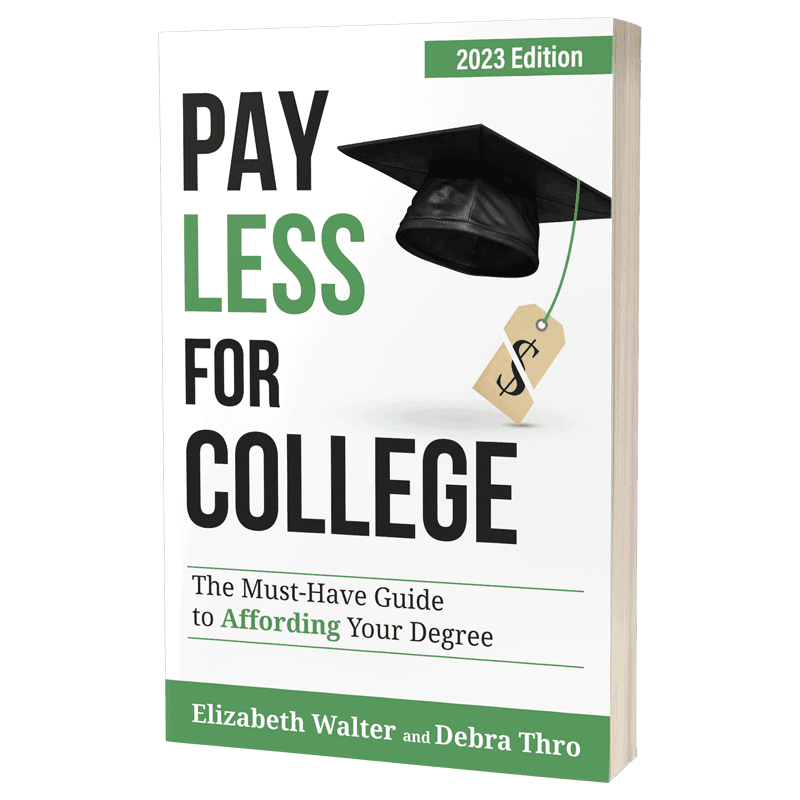Updated September 20, 2022
You don’t often see “good news” and “college costs” used in the same sentence, but here it is: We have some good news for families facing the burden of ever-increasing college costs. Yes, there are some simple, smart ways you can save real money, even tens of thousands of dollars, in overall college costs.
Not every option we offer is right for every family situation, but it is absolutely true that every family can find real savings using at least one of the following seven strategies:1. Attend Community College
Saves tens of thousands of dollars in tuition and dorm costs! If you are fortunate enough to live within commuting distance of a community college, consider earning credits there, or even a two-year Associate Degree, before transferring to a 4-year college to finish your Bachelor’s degree. Tuition is significantly lower at community colleges than at most 4-year colleges; and, as a commuter, you’ll also save between $8,000 – $20,000 per year on dorm costs. However, in order to make this option work financially, you must research ahead of time to make sure the 4-year colleges you are considering transferring to will accept all your community college credits toward the specific degree you seek. If some credits don’t transfer, you may have to take more than two years of classes at the 4-year college, thereby negating the value of attending community college first.2. Earn College Credit in High School
Saves tens of thousands of dollars in tuition! There are several ways to earn college credits while you are still in high school—potentially enough credits to graduate a semester or two early. TESTINGCollege Level Examination Program (CLEP)
CLEP tests, administered by the College Board, assess your college-level knowledge in 36 subject areas. Nearly 3000 colleges and universities accept CLEP scores for college credit but each school has its own policies regarding which exams they accept, what scores earn credit, and the total number of CLEP credits they will grant. You study for and take CLEP tests on your own time while in high school or college. Each test costs $89 and can earn you between 3 – 6 credits.Advanced Placement (AP)
AP courses offer college-level material, taught in high school or online, in 38 subject areas. AP exams are administered by the College Board each May. Nearly all colleges in the US accept AP scores for credit or placement out of certain classes, but each college has its own policies regarding which exams and scores will earn credit. Exams cost $96 each and a minimum score of 3, 4, or 5 is usually required for credit. DUAL ENROLLMENT (DE) Dual Enrollment programs allow 11th and 12th-grade high school students to enroll in one or two college classes per semester at a nearby college. Tuition is often significantly discounted, and sometimes even free, depending on the arrangement the college has with your high school or state. Some high schools offer DE classes right in their building taught by high school teachers. While these college-level classes can be excellent (and often are free), colleges are much less likely to accept them for credit than DE classes taken on a college campus. As with CLEP and AP, check with each college you are interested in attending to learn their policy on DE credit transfer.3. Parents: Enroll in a Tuition Payment Plan Instead of Borrowing
Saves the fees and interest charged for borrowing the same amount of money! Not all colleges offer them, but when available, tuition payment plans allow parents to pay all or a portion of each year’s tuition in 10 – 12 monthly, interest-free installments. Any amount of tuition paid this way saves the fees and interest you would otherwise have to pay on loans. You may feel you don’t have extra money available each month to put towards a tuition payment plan. However, with your child living at college, you will likely save hundreds of dollars on food, utilities, car insurance, and other costs each month–money that can go into a tuition payment plan. When parents borrow for college, the reality is that unless they are able to choose deferment until their child graduates, loan payments begin when the funds are disbursed, so they will have to find extra money to pay those costs anyway. It’s worth taking the time to crunch some numbers and see if a tuition payment plan can benefit you.4. Take a job on campus
Saves thousands of dollars in non-tuition costs! If you live on campus, one way to save a huge chunk of college costs is to take a job as a Resident Advisor (RA). Students who have been chosen to be RAs undergo extensive training to be advisors and supervisors of students in a dorm. RAs are given a free single room, sometimes free meals, and sometimes get paid an additional stipend. Depending on the college, an RA position can save you $6,000-$18,000 a year. Working other jobs while you’re in college can save you fees and interest on money you don’t have to borrow. A popular program for on-campus work is the Federal Work-Study program, available to students who have financial need (students whose EFC is less than the cost of attendance at the college). Work-study positions are flexible, average 10-20 hours a week of at least minimum wage, and the income earned will not affect your future EFC. Typical work-study jobs earn the student $1,500-$2,000/year—enough to cover some or most of the costs of books, supplies, personal expenses, and travel.5. Live off campus
Saves thousands of dollars on room and board costs! If you are able to attend a college close to home, consider living at home to eliminate college room and board costs, which average $11,950 per year at public colleges and $13,620 per year at private colleges. If you can move off campus, you may be able to save half or more of those costs by sharing rent with other students and cooking for yourself.6. Graduate early or on time
Saves tens of thousands of dollars in tuition! One of the most obvious and common-sense strategies to save on college costs is to try to graduate a semester or two early. But if that’s not possible, it’s crucial to graduate on time. While graduating on time doesn’t technically save on college costs, adding an extra semester or more has a staggering effect on overall college costs. Consider this: The average 4-year graduation rate at public colleges is only 36% and at private, non-profit colleges, only 54%. If it takes 5-6 years to get a 4-year degree, you will pay significantly more for that degree and lose wages you would have earned during your extra time in college. Low graduation rates for full-time, traditional students may be due to students’ poor planning or dropping classes, but is often caused by a college’s weak advising program and/or poor class scheduling and availability. However, many colleges do a very good job of graduating their students on time. When choosing schools to apply to, find out the 4- year graduation rates, both overall and in your possible majors, at all colleges of interest.7. Trim the small stuff
Trimming in small ways over four years can save you thousands!Rent your textbooks
You can save a bundle by renting your textbooks online for a fraction of the cost of purchasing them outright (eg. Chegg, AmazonTextbooks, ValoreBooks, and others). Shipping is usually free both ways. Your college bookstore may also offer textbook rentals.Buy new and used textbooks online
Both new and used textbooks sold online are often significantly cheaper than at your college bookstore.Re-sell textbooks to the college bookstore
Whether or not you purchase your textbooks from the college bookstore, you may be able to resell them to the bookstore at the end of the semester.Take a smaller meal plan
Examine your meal plan options carefully and choose the most flexible plan at the lowest price. Many students find they eat only two meals per day, yet often pay for three.Plan Your Travel in Advance
For some students, transportation between home and college can cost a bundle. Purchase plane or train tickets far in advance to save hundreds of dollars each year. If you live within driving distance, find people who live near your home who might be happy to take you home for the cost of ½ their gas.Leave your car at home
Registration and parking on campus can cost a lot, not to mention insurance and gasoline. You may find that your friends will frequently ask to borrow your car or ask you to drive, thereby adding to your expenses. Ditch the car and bring your bike instead.Identify all student discounts
Depending on arrangements between your college and the surrounding community, your student ID card can get you significant discounts on entertainment, local transportation, groceries, restaurants, and other purchases. The cure for that sinking, helpless feeling that comes with staggering, ever-increasing college costs is thoughtful planning that minimizes your Net Price (what you actually pay for college) and also addresses how you will meet those costs. A penny saved is not only a penny earned but a penny not borrowed with amortized, compounded interest. Anyone of these strategies can save families thousands of dollars. The more of them you can use, the more you will save.Learn More!
Paying for college shouldn’t be harder than going to college!



